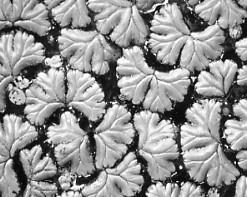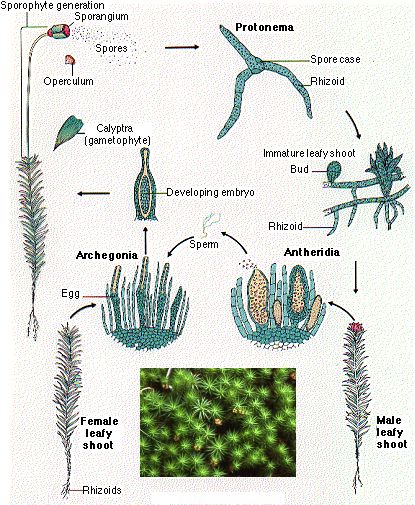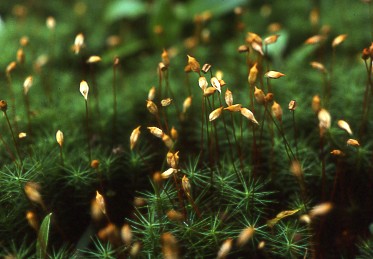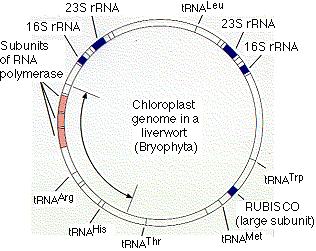Mosses and liverworts are traditionally classified together in the Division Bryophyta on the basis of their sharing:
 Some 23,000 species of living mosses and liverworts have been identified. These are small, fairly simple, plants usually found in moist locations.
Some 23,000 species of living mosses and liverworts have been identified. These are small, fairly simple, plants usually found in moist locations.
- Liverworts have a thin, leathery body that grows flat on moist soil or, in some cases, the surface of still water. The photo (courtesy of William C. Steere and AIBS Bulletin) is of a common liverwort, Ricciocarpus natans.
- Mosses have an erect shoot bearing tiny leaflike structures arranged in spirals.
Neither mosses nor liverworts have any woody tissue so they never grow very large. They have neither xylem nor phloem for the transport of water and food through the plant.

The leafy shoot of mosses is haploid and thus part of the gametophyte generation.
In the common haircap moss, Polytrichum commune (shown here), there are three kinds of shoots:
- female, which develop archegonia at their tip;
- A single egg forms in each archegonium.
- male, which develop antheridia at their tip;
- Multiple swimming sperm form in each antheridium.
- sterile, which do not form sex organs.
In early spring, raindrops splash sperm from male to female plants. These swim down the canal in the archegonium to the chamber containing the egg. The resulting zygote begins the sporophyte generation.
Mitosis of the zygote produces an embryo that grows into the mature sporophyte generation. It consists of:

- a foot, which absorbs water, minerals, and food from the parent gametophyte.
- a stalk, at the tip of which is formed a
- sporangium (the brownish objects in the photo).
The sporangium is
- filled with spore mother cells
- sealed by an operculum, and
- covered with a calyptra. The calyptra develops from the wall of the old archegonium and so is actually a part of the gametophyte generation. It is responsible for the common name ("haircap moss") of this species.
During the summer, each spore mother cell undergoes meiosis, producing four haploid spores — the start of the new gametophyte generation. Late in the summer, the calyptra and operculum become detached from the sporangium allowing the spores to be released.
These tiny spores are dispersed so effectively by the wind that many mosses are worldwide in their distribution.
If a spore reaches a suitable habitat, it germinates to form a filament of cells called a protonema. Soon buds appear and develop into the mature leafy shoots.
So,
- The gametophyte generation is responsible for sexual reproduction
- The sporophyte generation is responsible for dispersal.
Asexual Reproduction in the Mosses
Many species of moss never go through an alternation of generations; that is, they have no sexual reproduction. Reproduction is accomplished by fragments of sterile gametophytes breaking loose from the parent. If they land in a suitable habitat, these fragments can develop into a clone of the parent.
 The chloroplasts of mosses and liverworts, like those of all photosynthetic eukaryotes, contain multiple copies of a small genome: circular DNA molecules encoding some — but not all — of the genes needed for
The chloroplasts of mosses and liverworts, like those of all photosynthetic eukaryotes, contain multiple copies of a small genome: circular DNA molecules encoding some — but not all — of the genes needed for
- their own replication and
- photosynthesis.
Chloroplast genomes have been sequenced from representatives of most of the plant groups. Although they all contain the same genes, they fall into two distinct groups with respect to the organization of their genes.
- One group is illustrated by the figure, which shows the organization of the genome in Marchantia polymorpha, a liverwort. Between the two arrowheads is a stretch of some 30,000 base pairs. The order of the genes in this region is also found in mosses (supporting the idea that mosses and liverworts are, indeed, close relatives), and in the lycopsids — vascular plants (they have xylem and phloem) that have a fossil record going back over 400 million years.
- In all the other groups of plants, the same genes are present but in inverted order.
The mitochondrial DNA of plants further refines the evolutionary scenario. The mtDNA of all plants
- including mosses and lycopsids but
- NOT liverworts (nor green algae)
contain certain shared introns.
This suggests that liverworts may have been the first group of plants to evolve from algal ancestors.
1 September 2023
 Some 23,000 species of living mosses and liverworts have been identified. These are small, fairly simple, plants usually found in moist locations.
Some 23,000 species of living mosses and liverworts have been identified. These are small, fairly simple, plants usually found in moist locations.


